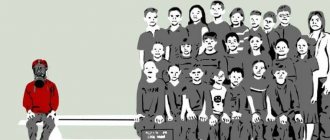Definition of concepts
External motivation is an incentive to activity through external forces. That is, a person perceives the reasons for his behavior as imposed, and considers himself just a pawn. Such motivation is regulated by external material and psychological conditions: money, reward and even punishment. The motivation to action is based on incentives that arise from the current situation.
Intrinsic motivation is determined by the needs for competence and personal choice, which are leading for the human “I”. With this type of motivation, people understand that they are the true cause of what is being done, and perceive themselves as an effective agent when interacting with the environment. That is, in the case of internal motivation, needs, interests, intentions, goals, desires, self-confidence, the possibility of self-realization, and a sense of satisfaction from work are used.
Let's consider each type of motivation separately.
Victor Vroom's Expectancy Theory
Psychologist Victor Vroom explored how employee motivation can be managed in the field of labor relations. In 1964, he formulated a theory in which he described some of the mechanisms on which people's motivation to work and high productivity depend.
Vroom approached the issues of motivation taking into account the psychological characteristics of the individual. Motivation here is considered as what determines the choice of one of the forms of voluntary behavior, and what a person sees as the result of this choice and influences it. Vroom identified three key components that determine how motivated a person is to do something. These are expectation, facilitation (instrumentality) and valence. Let's decipher these concepts:
- Expectation is the belief that a particular effort can bring about better performance and efficiency (and through it, a desired outcome, such as becoming an industry leader or winning a competition). Those. a person sees the meaning of performing specific actions or work because he believes that, with due diligence, they will lead to a positive effect. In this parameter, many factors are important, such as the presence of the necessary skills and abilities, the availability of resources, the employee’s self-esteem, the complexity of the goals and the ability to influence the achievement of the result. When the expectation parameter is met, effort leads to greater performance.
- Promotion describes how hard work and high performance are expected to be rewarded. This indicator is higher, the greater the confidence that the reward will be given to the one who worked the hardest or made the greatest contribution to achieving the result, and not everyone. Things that matter here include trust in the person distributing the reward, some control over this process, and clear rules for assigning rewards.
- Valence to the desirability of a reward and the extent to which it corresponds to an individual’s values. This parameter is determined by many individual factors, such as personal values, needs, goals, preferences, source of motivation, etc.
Expectancy theory of motivation was created by Vroom for application in the field of labor relations and management, and since its introduction in 1964, it has been subject to many additions and criticisms. The main criticism was the simplicity of the model, and it was shown that in some cases such an approach is not effective or loses it over time. Nevertheless, the system developed by Victor Vroom is a more accurately describing model of motivation than, for example, incentive theory. According to the latter, to create motivation, it is enough to simply reward the desired behavior (i.e., simply dangle a carrot in front of someone).
It is important to realize that any theory has its limitations, and even more so one that describes such a complex and little predictable apparatus as a person’s personal motivation and his attitude to work. The only conclusion that we can safely draw is that in the matter of motivation there are no universal rules and mechanisms, as well as unchanging, eternal constants and always working schemes. The appropriate “sticks,” “carrots,” and “carrots” need to be selected individually for different people and different situations.
In addition, other scientific works have demonstrated that extrinsic motivation is influenced by such subjective characteristics of a person as self-esteem, locus of control (the degree of confidence that I myself am able to control the circumstances affecting my life), self-efficacy (the belief that in a difficult situation situation, I will be able to act actively and effectively) and neuroticism. For example, praise will work less for people with high self-esteem than for those who seek confirmation of their worth. On the other hand, someone who has high levels of anxiety or a need to prove something may work harder and more persistently than others, and their behavior can be more easily rewarded with smaller rewards.
We have looked at the range of different factors influencing motivation, now it’s time to take stock. Let's also see how we can apply the above to life. But first, a small test to check how well you have mastered the material in the article:
Now let's summarize.
Extrinsic motivation
The employees were promised a bonus and they started working faster. They established fines and rules, people began to focus on them, whether they liked it or not. A suddenly appearing thundercloud makes you run home faster. The criminal pointed a gun at you and demanded money - you will immediately give up your wallet.
These are all examples of extrinsic motivation. As already mentioned, it encourages action through prevailing circumstances or incentives. In another way, we can say that these are achievements in the surrounding society. Of course, internal motivation is much more effective. However, this type of influence has a better effect on individuals.
So, what methods are suitable as external motivation? Career growth, big salary, prestigious things (apartment, house, car), status, opportunity to travel, recognition.
Extrinsic motivation can constantly change. Yesterday you had to earn money to feed your family, and tomorrow you will need money for a new apartment, car or children’s education. The most obvious and classic example of such motivation is the fairy tale about the goldfish and the fisherman.
Development methods
Theories of motivation play an important role for a person, because by understanding how motivation is formed, you can use this information to achieve your goals. A successful person must successfully use different types of useful motivation and be able to motivate others when necessary. After studying the theoretical material, you can choose the most useful approach for yourself and stick to it in everyday life.
However, not everyone knows what it means to motivate themselves and others. Various motivation methods are used by specialists for employees and students. There are also methods of self-motivation, which include:
- Reading and repeating affirmations;
- Self-hypnosis;
- Studying the life path of great people;
- Visualization;
Studying theories of motivation for a person helps to better understand one's own behavior and the behavior of other people, and develop a plan to increase productivity. Once you decide what it means to motivate yourself to act, solving many problems will no longer be a problem for you over time.
Achieving success in life is determined not only by motivation, but also by some other skills, for example, non-standard approaches to solving problems. The necessary brain functions allow you to develop individually designed workouts on the BrainApps resource, which take into account the strengths and weaknesses of the brain.
Intrinsic motivation
A small child is constantly trying or exploring something. This is really important and interesting to him. A person works not for a salary, but because of what he loves. These are examples of intrinsic motivation. As already mentioned, it does not depend on external factors and the environment. The very content of the activity encourages a person to engage in it.
What can you use as internal motivation? The opportunity for personal growth, a sense of need, self-affirmation, the implementation of ideas, creativity, the need for communication, the fulfillment of dreams.
Intrinsic motivation of an employee is when he views his work as a paid hobby. Perhaps, if not all, then many people would like to strive for this.
It is much more effective to use both types of motivation. The main thing is to maintain balance and balance between them.
Structure
The basis of motivation is its strong connection with human needs. A person strives to reduce the tension that develops against the background of need. He also strives to cover various needs (social and biological).
The structure of the concept is presented in the form of a chain of related elements: need - motivation - actions - goal.
It all starts with a feeling of discomfort experienced by a person as a result of a lack of something. From this feeling comes motivation to act , and then action, which ultimately leads to the goal. As soon as one need is fulfilled, the next cycle begins.
Motivation cannot exist as an independent unit.
In order for a person to be motivated to take certain actions, he must have an unsatisfied need and an ultimate goal .
Stages of motivation:
- The occurrence of discomfort. A person understands that he lacks something to organize normal life activities.
- Searching for options to get rid of discomfort (fill a need). The person considers options for satisfaction, suppressive control, replacement, and switching to other needs. He strives to get rid of the growing discomfort in the simplest and most justifiable way.
- Setting a goal. A person must understand what means he uses and what result he will get.
- Active actions. Volitional impulse and activity aimed at satisfying needs.
- Expected reward. Having achieved certain results, a person receives a reward (in the form of satisfying a need).
As an additional reward, he can receive positive emotions and joy from fulfilling his dreams. - Closing the need. If a person has chosen the right behavior strategy and completed all the necessary actions, the need will disappear (forever or for a certain period of time).
May have a negative impact on the process:
- multiplicity of motives (a person experiences several needs at once and cannot identify the dominant one, as a result of which it becomes very difficult to build a behavioral strategy);
- variety of motivational structures (their types) in people.
How motivation factors work
In fact, all motivational factors can be boiled down to two ideas:
- Enjoy. These are positive factors.
- Get rid of the unpleasant. These are already negative factors.
All of them can be both external and internal. The simultaneous presence of positive and negative factors has a beneficial effect on action. It turns out to be a very powerful push, a kind of push-pull. On the one hand, a person wants to receive a reward, and on the other hand, he avoids punishment.
External and internal motivation, positive and negative factors act in different ways, in different directions and always lead to different results. Of course, people are affected by all types of influences to some extent. However, it can be seen that each person still gives preference to one direction. One needs to be constantly pushed and intimidated, while the other needs only to be promised a reward.
For clarity, below is a table that can be used to motivate employees.
An example of applying knowledge about motivation
The above story will tell and clearly show how external and internal motivation works.
Every evening, under the windows of an elderly woman, a group of children gathered, playing and communicating very noisily. Naturally, the old woman did not like this, but her requests and persuasion to spend her leisure time elsewhere did not help. Then she decided to change the situation in a different way.
Every day the woman gave the children fifty rubles for playing very well near her house. Of course, the kids liked this arrangement! The old woman began to gradually reduce this amount. And at one point, when the children thought they were being cheap, they simply refused to play under her windows and never appeared there again.
This is the cunning way the woman solved the situation. The children's internal motivation (their own desire to play under the windows) was transferred to external motivation (doing it for money), but then that too disappeared.
Types of motives and motivation for educational activities
Creative work
On the topic “Knowledge is the children of wonder and curiosity
(on the issue of motivation for schoolchildren’s learning)"
Kovdor, 2004
© svetlana.pro
2. Types of motives and motivation for educational activities
The topic of motive and motivation is very well developed in educational psychology, and this, oddly enough, creates certain difficulties in mastering this topic, since psychologists often have several different opinions on the same issue, and therefore different methods for identifying what -or fact. It seems that the only way to solve these difficulties is to determine your own position on this problem, and choose for your work those terms, those methods that are more understandable and closer to the “style” of teaching. Which is what I did in my subsequent work.
For a better understanding of the problem, it is advisable to agree on the unambiguous definitions of the terms “motive” and “motivation”, although in psychology there are different definitions of these concepts.
So: what is a “motive”?
Motive is what motivates an activity
(is a form of manifestation of need).
What is "motivation"?
Motivation is the process of motivating yourself and others.
to activities to achieve personal goals.
So, there are several classifications of motives, I will list some of them.
2.1. Classification of motives according to T. A. Ilyina
Motives directly motivating:
- depend on the personality and activities of the teacher, the selected material, and methods.
- rely on involuntary attention and are based on positive emotions.
Prospective motives:
- are associated with the student’s own goal-orientation and the focus of his activities on the future.
- this is an interest in a subject, in a certain activity for which there is an inclination; desire to earn the approval of comrades.
- motives can often be associated with negative emotions - fear of the teacher, parents.
- rely on voluntary attention associated with a consciously set goal.
Motives of intellectual motivation:
- interest in the process of mental activity;
- the desire to find an independent answer to a question, a feeling of satisfaction from a successful solution, a feeling of satisfaction from the process of mental work itself;
- the awakening and maintenance of such interests depends on the teacher, i.e. It is necessary to teach students methods of mental activity and mastery of general educational skills.
This division is very conditional, the motives intertwine with each other, transform into one another, and unite; in addition, the ratio of motives varies depending on age; So in the lower grades, directly motivating motives predominate; in the older ones – promising, stimulating and social.
2.2. Another version of the classification of teaching motives according to T. A. Ilyina (based on two tendencies: to achieve success and avoid failure)
The teacher’s task in this case is to develop in students the desire for success, to encourage even small achievements, and not to focus on failures.
2.3. Variant of classification of motives according to A.K. Markova
(characterizing the attitude towards the activity itself)
According to the same classification, external motives are called social, and internal motives are called cognitive (it is this classification that I will use in the future).
2.4. Conclusions based on the student’s activities
- The leading motives for student activity can be both external and internal motives. Of course, we all want our students’ activities to be guided by internal motives, but external motivation can also lead to setting goals for the activity, as long as it is not a negative (fear of a bad grade), but a positive motive (the desire to get a good grade).
- It is extremely important to know the dynamics of the development of motives, and to ensure that external positive motives do not turn into external negative ones. With properly delivered training, the opposite happens; interest in the teacher develops into interest in the subject and, later, in the science he represents.
- In reality, each student is motivated by several motives, because... educational activities are always multi-motivated.
2.5. Variant of classification of motives according to E. P. Ilyin
To understand the specifics of the motive, it is necessary to correlate them with age. The age characteristics of children influence motivation. For example, the willingness of schoolchildren to obey the demands of adults sharply decreases from the 4th to the 7th grade, which indicates a decrease in the role of external and an increase in internal motivation. Unfortunately, this fact is rarely taken into account by both parents and teachers.
Now it will be interesting to see how a student’s educational activities are motivated by age. Below I present a table showing age and the motive corresponding to age (the table is compiled in an overview, and the motives are deliberately simplified, and some are not even included, since the main purpose of this table is to show another principle of classification, as well as to show the relationship between age and motive ).
Table “Motives for educational activities”
| Age/Group | Motive |
| First graders (preschoolers) |
|
| Junior schoolchildren |
|
| Middle classes |
|
| Senior classes |
|
As can be seen from this table, the motive changes with age, and changes because needs change. I propose to look at the relationship between motive and need and see how clearly the need determines the motive.
The sequence of appearance of needs in ontogenesis is from bottom to top (according to A. Maslow):
The sequence of appearance of motives (compiled by the author of the study):
2.6. Methods of motivation according to D. G. Levites
Psychologists and teachers offer different methods of motivation. I settled on those that seem more acceptable to me from the point of view of using them in every lesson. These are the following methods:
I will dwell in more detail on each method of motivation, accompanying it with the following explanations: the essence of the method is through an aphorism; what does this method provide, or what is its result; what this method “requires” for its best application; In addition, I accompanied each method with a photograph of my own lessons, when I used one or another method. I’ll immediately make a reservation that showing the motivation methods “culture of communication” and “sense of humor” in the photo turned out to be problematic - not because I don’t use these methods, but because it’s also impossible to photograph the smell of “Chanel No. 5”.
© svetlana.pro
Motivating others
People who are motivated by upward striving do not pay attention to comfort. They are driven by the pursuit of personal interests and organizational goals. Employees who are driven by punishment will not do things that take them out of their comfort zone.
It is very important to take into account external positive factors. These are money, reliability, conditions and safety. Internal positive factors play an equally important role. These are achievement, growth, empowerment, recognition and responsibility. Only the right combination of these factors will give job satisfaction. In their absence, work becomes hateful and unbearable. In this regard, the motivation of students or schoolchildren is no different. It is important that internal learning motivation prevails.
Diagnostics
Through multiple experiments, it was found that there is an optimal level of motivation. And diagnostics of this area makes it possible to determine how much the real level corresponds to the optimal level .
To carry out diagnostics, special techniques are used:
- Thematic Apperception Test (TAT);
- Heckhausen motivation test;
- technique of color metaphors;
- repertory grid technique;
- Need for Achievement Questionnaire (Yu. Orlov).
In addition the interview method , when data is collected through personal contact between a specialist and the subject.
Signs of a motivating environment
When organizing any activity, it is important to consider several requirements. They are simply necessary to satisfy needs and form the right motivation:
- Activities should be creative and varied.
- Opportunity to develop while completing tasks.
- A sense of belonging to a group and recognition from it.
- The right to make decisions independently within one’s competence.
- Feeling of support and help.
- The presence of external attributes of success: praise, encouragement, compliment.
- The meaning of the required actions.
- The opportunity to express your own opinion, which will be taken into account.
- Availability and timeliness of information received.
- Feedback after the work done.
If all these signs (or at least the majority) are present in the organization of activities, then we can assume that the formation of internal motivation will be successful.
Self-motivation is the engine of progress
For meaningful movement, it is important to know where to come from and where to go, as well as to have a great desire. That is, self-motivation is necessary. How to achieve it? Follow the techniques and rules listed below:
- Set yourself only achievable goals. Only then will there be a desire to achieve them.
- Break big goals into small tasks.
- Keep a diary of achievements.
- Constantly reward yourself with rewards for completed tasks.
- Try to use as little criticism as possible.
- Look for like-minded people in your business.
- Try to compete with others and become the best.
- Surround yourself only with positive and goal-oriented people.
- Read books and watch movies that motivate you.
Try to implement, if not all, then at least a few points, and you will definitely have a desire to get down to business! Remember that it is important to use positive and negative factors, internal and external motivation in balance in order to achieve a good result.











